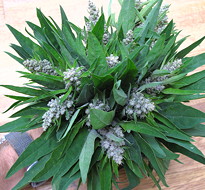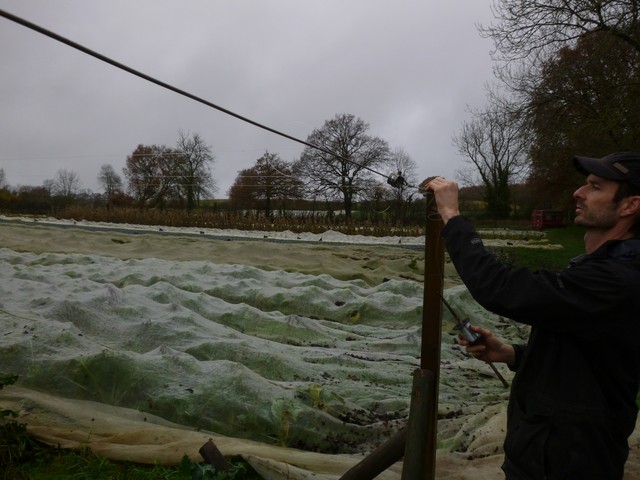2020 – June news: Rain at Last
We’ve tried prayer, raindances and even some of the spells out of Harry Potter and finally it has worked as at last some decent rain arrived for our crops this week. This is particularly timely as we have been very busy getting some important crops in the ground: cabbages, kale and over 5000 leeks have all been planted in the last fortnight. Also, with the maincrop carrots and parsnips just emerging and getting established, the downpours are particularly welcome. The only question is: after 3 months of moaning about how dry it all is, how long before the growers start moaning that it’s too wet?

Kale awaiting planting 
Planting team at work
2020 – May news: Don’t Mind the Gap
The spell from mid May to mid June is the dreaded ‘hungry gap’: the time when the growers are scratching around down the back of the sofa desperate for anything, anything at all vaguely veg-like to put in the share. Well, don’t know if you’ve noticed but that hasn’t really happened this year!
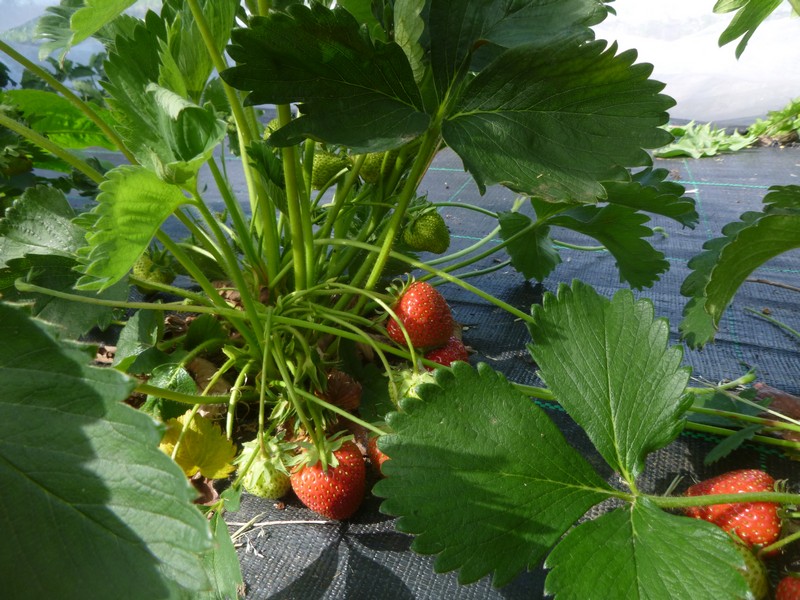
Early strawberries, ripe for the picking 
The first strawberry shares
New projects (e.g. the strawberries) have come good, new varieties have thrived (e.g. overwintering broad beans and onions) and our usual staples are all here a bit earlier (e.g. tunnel carrots and potatoes).

Bumperlicious cucumbers 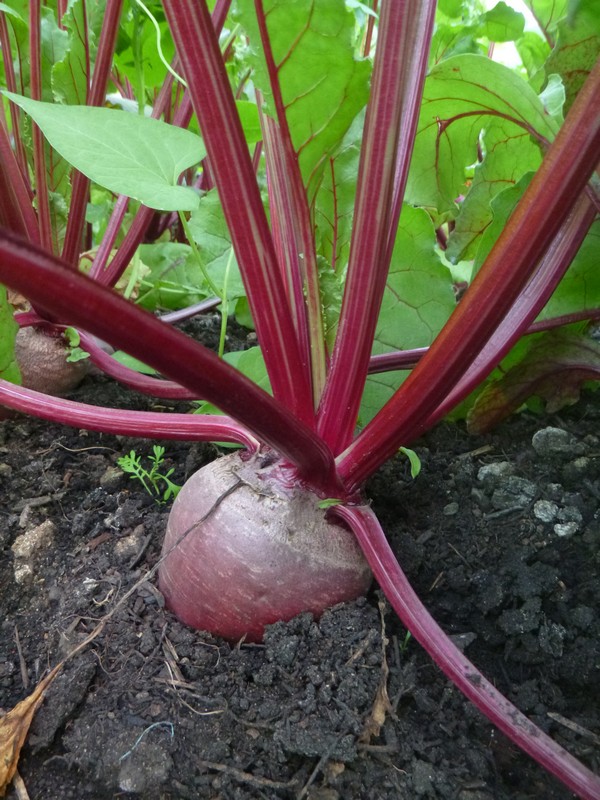
Tunnel beets looking swell!
The weather has been outstanding for early production (provided we can get enough water out there), but most of all it is down to our superb volunteers, toiling away – at a social distance – in the baking heat every Wednesday and Saturday. You have kept the crops weed free and got the seeds sown, and kept us well ahead of the game at a crucial time. Enjoy the bumper ‘hungry gap’ share!
Virtual blossom walk
The orchard is looking amazing at the moment – the apple blossom is at its peak and the cherry trees that still have blossom have an abundance of it! Hopefully all the blossom foretells of a bountiful crop of fruit this summer, all being well through the growing season.
Click here to watch:
Credits: Filming, editing and music: Eleanor Brown
2020 – April news: Royal Variety Performance: Grafting Apples
What do you do if you plant an apple tree and, after ten years of care, the variety you’ve gone for just isn’t performing? One of ours, ‘Tydeman’s Late Orange’, has given us this problem, with a decade of low yield, tiny scabby fruit and other misdemeanours.

Scionwood ready to go 
The unproductive tree
All is not lost – this week Dom has been grafting a new, favoured variety (‘Edward VII’, hence royal) onto the old TLO trees. This involves cutting the tree right back to a few decent stumps (leaving one as a ‘sap drawer’) and in this case cleaving into the wood and wedging two tiny scions (twigs from the preferred variety, cut in winter and stored in the fridge) into the edges of the cleft.
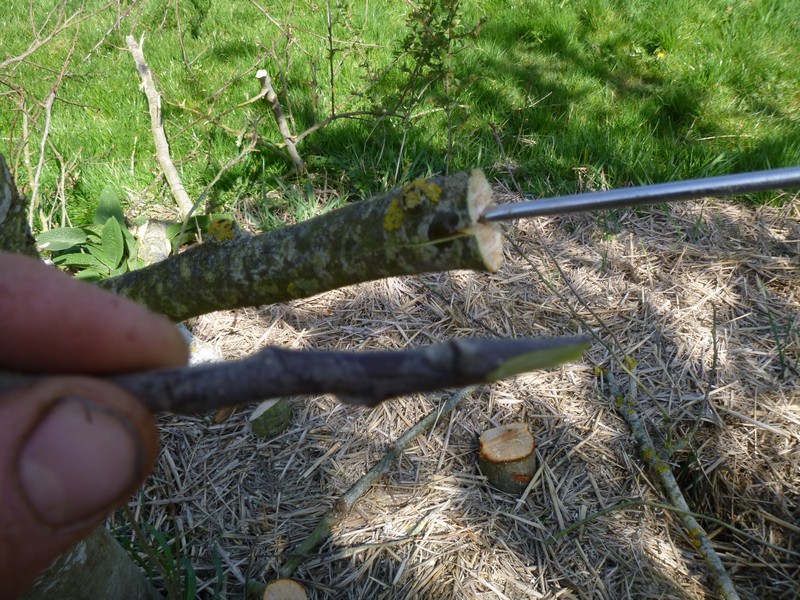
The prepared scionwood 
Sealing the cut with wax
The wounds are taped up and sealed with wax. The Edward VII scions will grow with the vigour of a ten-year old tree rather than a new sapling and will reach a good size in no time, so this is a much quicker way than replacing the tree entirely – those 10 years were not totally wasted.
Onion planting – still needs to happen despite COVID-19…
This year’s onion planting will happen in a slightly different way to usual, to make sure this big annual task can be completed whilst at the same time enabling members to get out in the fresh air and still maintain the recommended social distancing measures.
Come and help plant the main onion crop – a task suitable for all ages! The work will continue for as many days as needed (Tuesday-Saturday) and any member who is well and symptom free, and has not been advised to self-isolate, is welcome to come and join in – the work will be arranged so that social distancing measures can be maintained.
Due to COVID-19 we will not be providing any refreshments or arranging shared food during onion planting work sessions. You are encouraged to bring a flask with your own hot drinks, and are welcome to bring a packed lunch if you want to work both sides of lunchtime.
We will be contacting members to let them know when the work can start (dependent on the ground being dry enough for the land to be prepared). Saturday 4th April or 11th April onwards – to be advised
2020 – March news: A Load of Crap
Many people have an idealistic mental image of land work, of ruddy-cheeked farmhands chewing a stalk of hay, cheerfully digging carrots against a bucolic backdrop of butterflies fluttering across wildflower meadows.
This week, however, reality came crashing down as the time finally came to dig out the compost toilet. You may be aware that one half of the toilets has been shut for the last six months to allow its contents to decompose and pathogens to die off; consequently much of what we “harvested” was beautiful black gold, well-rotted compost with a pleasant aroma of nutrition and fertility, a far cry from its stinky beginnings, such is the cycle of order and chaos that we call nature.

Digging out the toilet chamber 
A trailer load of humanure
Organic regulations prohibit the use of this “humanure” in growing, so we got permission to deposit it in an inaccessible corner of a nearby private woodland. Find out more about compost toilets at https://humanurehandbook.com/.
2020 – February news: Wet and wild
For two successive weekends we have had been battered by wet and windy weather, and many members have expressed concern about the consequences for our infrastructure and crops. Fortunately Canalside has emerged unscathed, with the tunnels and other structures all surviving the wind without a hitch (touch wood!), and most of our field-stored crops seem to be coping well with the repeated deluges. You might think farmers are helpless against the onslaught of brutal storms, but there are many farming practices that can really help mitigate the effect of extreme rainfall that we’ve seen over the last five months, most of which are integral to the organic approach and involve protecting and nourishing healthy soil as your most precious resource.
^ Leasowe Farm’s Tallis Wood: trees help hold back water in the landscape
Green manures: winter ground cover protects the soil ^
You may also be interested in this article which describes some of the factors from agricultural practices that contribute to flooding.
2020 – January news: New Veg on the Block
Most years we experiment with a new vegetable; sometimes this works a treat (New Zealand spinach) and sometimes not so well (salsify – although it does have a few fans). For 2020 we have 2 new vegetables coming to the farm: huauzontle (pronounced wah-ZONT-lay), also known as Aztec broccoli, is the spinach family’s answer to broccoli – you eat the unopened flower heads; and amaranth, which we did actually sow in 2016 but never got around to planting out, so as they say, if at first you don’t succeed, fail, fail again… this is leaf amaranth rather than the varieties grown for the quinoa-like seed that you might have seen for sale in wholefood shops.
Photos from https://www.realseeds.co.uk/cookinggreens.html
2019 – December news: The Final Straw

Dom says, “One of my favourite jobs in the yearly calendar is covering up our carrots with straw to protect them from the worst of the winter frosts. Volunteers and growers tackled this job with relish on Wednesday, rolling some big bales down the field with the usual thrilling risk that some of them might gain momentum and end up in the canal (bales, not volunteers). “

2019 – November news: Bird on a Wire
This is the week when we go through the annual ritual of taking the mesh off our purple sprouting broccoli crop (the fabric damages the emerging sprouts) and fix long lines of fishing wire above the plants, to keep the pesky pigeons off. It sounds strange but the technique works a treat (the birds are simply unable to settle on the crop to feed), at a time of year when they can really massacre your brassicas as other food sources dimish.




